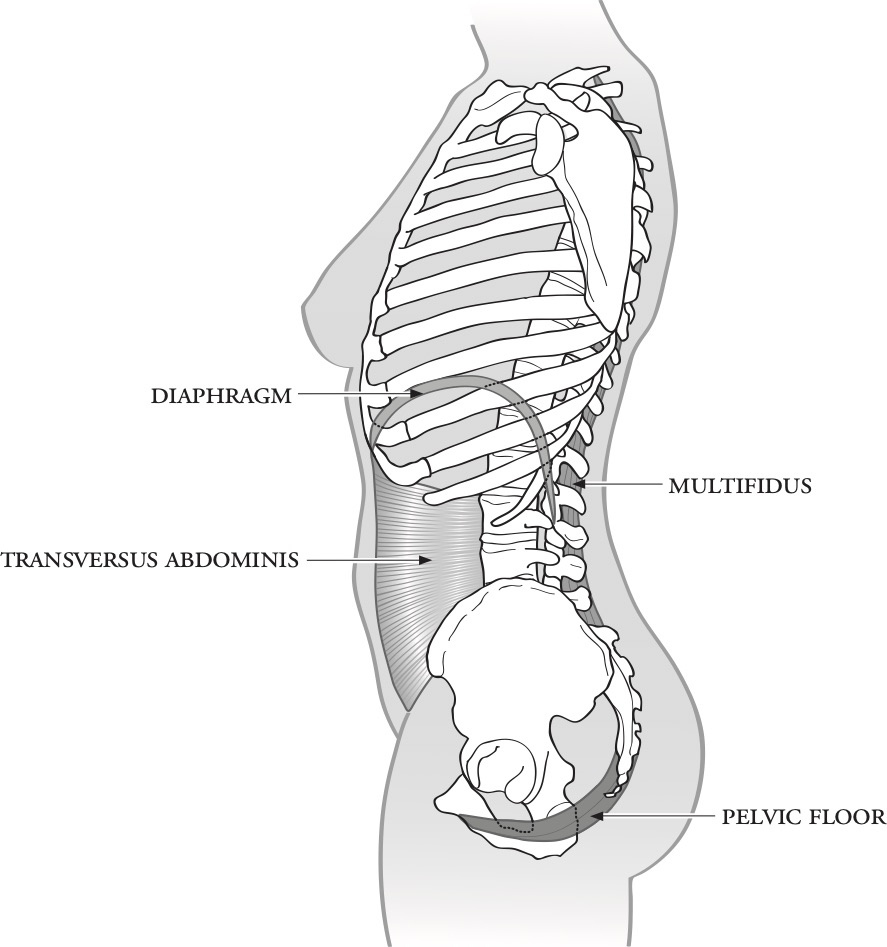Demystifying the Core
The “Core-Tet”
In Neutral Spine, there are four muscles that support the spine: transversus abdominis, Multifidus, Pelvic floor, and Diaphragm.
Multifidus: The New Powerhouse
In the world of sports medicine research, the multifidus muscle is now all the rage. Formerly thought to be relatively unimportant muscle based on its fairly small size, recent research shows that it’s actually the strongest muscle in the back because of its unique structure. The Multifidus has short fibers arranged within rods which are stiffer than any other in the body, serving a critical function as a stabilizer of the lumbar spine.
The very thin multifidus is deep in the spine, spans three joint segments, and works to stabilize the joints at each segmental level. The multifidus lies deep to the spinal erectors, transverse abdominis, and internal and external obliques.
The lumbar vertebrae carry the most body weight and are subject to the most force and stress along the spine. The multifidus muscle keeps us vertical and takes pressure off the discs.
Common wisdom in rehabilitation circles now is that injury to the spine (including surgery to treat spinal disorders) may disrupt the multifidus, decreasing spinal stability and increasing lower back pain.
The Transversus Abdominis
The transversus abdominis is the deepest abdominal muscle which functions to hold the viscera in and compress the abdominal wall. Its fibers run transversely, holding the belly in like a drawstring that runs all the way around the back and attaches to lumbar fascia. And because the transversus abdominis runs transversely, it has little to no effect in flexing the spine. It is mainly a stabilizer, not a mover. And that’s why it’s so important for core stability, and that is also why we find the Core when the spine is in neutral. For when the spine is in flexion, as in “flat back” or posterior pelvic tilt, the other 3 abdominal muscles are now contributing to the movement, and we are no longer practicing stability in the position that your spine should live in during daily life activities. It’s not wrong to do “flat back” exercises, but it turns on the superficial abdominal muscles as well as putting the multifidus muscle on stretch.
The Pelvic Floor
The Pelvic Floor holds up and tones the genitals and anus and keeps other organs from bearing down and prolapsing, and it also supports the bottom of the core by lifting up from below. Some say the Pelvic Floor interdigitates with the transversus abdominis and the multifidus. To engage the Pelvic Floor, draw the two sides of your pubic bone in front closer to the two sides of your tailbone in back, forming a “hammock” lifting up from the center. Women who have been pregnant normally are advised to practice Kegel exercises to prepare for birth, and post-partum to strengthen and regain pelvic floor tone. For men, think of pulling up your family jewels. When the pelvic floor engages, one should feel a deeper engagement of the transversus and multifidus.
The Diaphragm
The Diaphragm is the major muscle of breathing but it also acts as the “top” of the Core. When you inhale, the Diaphragm contracts and dips downward, allowing air to enter the thoracic cavity. I usually have people engage their Core-Tet on the exhale, as the diaphragm eccentrically contracts and draws up, you can think of drawing the pelvic floor up with it, as if they are two parachutes connected by a string in the middle. As the diaphragm floats up, it pulls up the pelvic floor, which in turn helps to draw the belly in and lift the lumbar spine closer to the center of the body.
Finding Your Core-Tet
The first step to find your Core-Tet is finding your neutral spine with its 3 main curves: lumbar, thoracic, and cervical. When pelvis and spine are in a neutral position, the lumbar spine has a convex curve and should be in slight extension, the thoracic spine has a concave curve and should be in slight flexion and the cervical spine has a convex curve and should be in slight extension.
You can find your Core-Tet in any position that you find neutral spine, but most commonly in the Pilates world we try to find the Core in Supine Neutral, Prone Neutral, All Fours Neutral and Side Lying Neutral. Once you’ve mastered finding the Core-Tet in these positions, then you can engage your core when you sit, stand and walk (which is the ultimate goal).
When the core is engaged in neutral position, we think of drawing the abdominals in toward the spine like a girdle with hooks in the back that wraps around the waist and cinches together at the spine, drawing the abdominal wall inward. Meanwhile, the lumbar spine should be in a slightly extended position when in neutral, so that the multifidus muscles that run between the vertebrae and up the spine are also engaged and “lifted.” These muscles “hug” the spine like corn hugging a dog. If you think of the spine like a tall thin flexible tower that needs support, the transversus abdominis and the multifidus are like guy wires on either side supporting and stabilizing the tower against the forces pulling it in different directions.
When you find your Core-Tet you should feel a sandwich of support on the front and back of your lumbar spine as well as a feeling of lifting from the base of your pelvis up to your sternum.

